
A Study in Scarlet is an 1887 detective novel by British writer Arthur Conan Doyle. The story marks the first appearance of Sherlock Holmes and Dr. Watson, who would become the most famous detective duo in English literature. The book's title derives from a speech given by Holmes, a consulting detective, to his friend and chronicler Watson on the nature of his work, in which he describes the story's murder investigation as his "study in scarlet": "There's the scarlet thread of murder running through the colourless skein of life, and our duty is to unravel it, and isolate it, and expose every inch of it."

"The Adventure of the Bruce-Partington Plans" is one of the 56 Sherlock Holmes short stories written by Sir Arthur Conan Doyle. It is one of eight stories in the cycle collected as His Last Bow (1917), and is the second and final main appearance of Mycroft Holmes. It was originally published in The Strand Magazine in the United Kingdom and in Collier's in the United States in 1908.
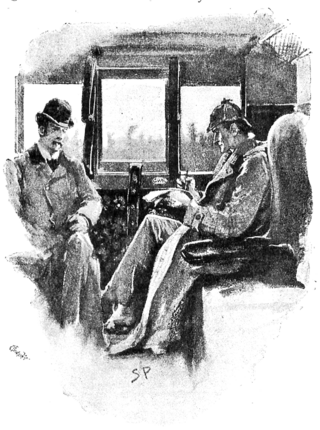
"The Boscombe Valley Mystery", one of the fifty-six short Sherlock Holmes stories written by Sir Arthur Conan Doyle, is the fourth of the twelve stories in The Adventures of Sherlock Holmes. It was first published in the Strand Magazine in October 1891.

Detective Inspector G. Lestrade is a fictional character appearing in the Sherlock Holmes stories written by Arthur Conan Doyle. Lestrade's first appearance was in the first Sherlock Holmes story, the 1887 novel A Study in Scarlet. His last appearance is in the 1924 short story "The Adventure of the Three Garridebs", which is included in the collection The Case-Book of Sherlock Holmes.
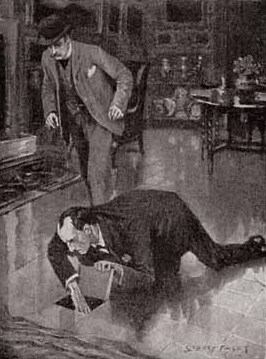
"The Adventure of the Second Stain", one of the 56 Sherlock Holmes short stories written by Sir Arthur Conan Doyle, is one of 13 stories in the cycle collected as The Return of Sherlock Holmes (1905) and the only unrecorded case mentioned passively by Watson to be written. It was first published in The Strand Magazine in the United Kingdom in December 1904, and was also published in Collier's in the United States on 28 January 1905. Doyle ranked "The Adventure of the Second Stain" eighth in his list of his twelve favourite Holmes stories.

"The Adventure of the Norwood Builder", one of the 56 short Sherlock Holmes stories written by Sir Arthur Conan Doyle, is the second tale from The Return of Sherlock Holmes. The story was first published in Collier's (US) on 31 October 1903 and in The Strand Magazine (UK) in November 1903.
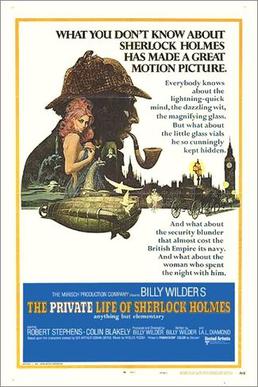
The Private Life of Sherlock Holmes is a 1970 DeLuxe Color film in Panavision written and produced by Billy Wilder and I. A. L. Diamond, and directed by Wilder. The film offers an affectionate, slightly parodic look at Sherlock Holmes, and draws a distinction between the "real" Holmes and the character portrayed by Watson in his stories for The Strand magazine. It stars Robert Stephens as Holmes and Colin Blakely as Doctor Watson.

A Study in Terror is a 1965 British thriller film directed by James Hill and starring John Neville as Sherlock Holmes and Donald Houston as Dr. Watson. It was filmed at Shepperton Studios, London, with some location work at Osterley House in Middlesex.
Sherlock Holmes has long been a popular character for pastiche, Holmes-related work by authors and creators other than Arthur Conan Doyle. Their works can be grouped into four broad categories:

Terror by Night is a 1946 Sherlock Holmes crime drama directed by Roy William Neill and starring Basil Rathbone and Nigel Bruce. The story revolves around the theft of a famous diamond aboard a train.
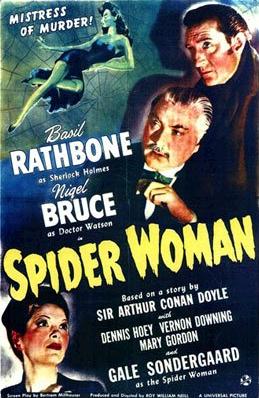
The Spider Woman is a 1943 mystery film starring Basil Rathbone as Sherlock Holmes and Nigel Bruce as Dr. Watson, the seventh of fourteen such films the pair were involved in. As with all of the Universal Studios films in the series, the film is set in then-present day as opposed to the Victorian setting of the original stories. This film incorporates elements from the 1890 novel The Sign of the Four, as well as the short stories "The Final Problem", "The Adventure of the Empty House", "The Adventure of the Speckled Band" and makes explicit reference to "The Adventure of the Devil's Foot".

The House of Fear is a 1945 Sherlock Holmes crime film starring Basil Rathbone and Nigel Bruce. Directed by Roy William Neill, it is loosely based on the 1891 short story "The Five Orange Pips" by Arthur Conan Doyle. It is the 10th film of the Rathbone/Bruce collaboration as Holmes and Dr. Watson.

Sherlock Holmes and the Secret Weapon (1942) is the fourth in the Basil Rathbone/Nigel Bruce series of 14 Sherlock Holmes films which updated the characters created by Sir Arthur Conan Doyle to the then present day. The film is credited as an adaptation of Conan Doyle's 1903 short story "The Adventure of the Dancing Men," though the only element from the source material is the dancing men code. Rather, it is a spy film taking place on the background of the then ongoing Second World War with an original premise. The film concerns the kidnapping of a Swiss scientist by their nemesis Professor Moriarty, to steal a new bomb sight and sell it to Nazi Germany. Sherlock Holmes and Dr. John Watson have to crack a secret code in order to save the country.

Sherlock Holmes Faces Death is the sixth film in the Basil Rathbone/Nigel Bruce series of Sherlock Holmes films. Made in 1943, it is a loose adaptation of Sir Arthur Conan Doyle's 1893 Holmes short story "The Adventure of the Musgrave Ritual". Its three immediate predecessors in the film series were World War II spy adventures with Holmes and Dr. Watson helping the Allies thwart enemy agents, but this one marked a return to the pure mystery film form. Though several characters are military men and there are frequent mentions of the ongoing war, it is not the focus of the story.

The Sleeping Cardinal, also known as Sherlock Holmes' Fatal Hour in the United States, is a 1931 British mystery film directed by Leslie S. Hiscott and starring Arthur Wontner and Ian Fleming. The film is an adaptation of the Sherlock Holmes stories by Arthur Conan Doyle. Although it is not based on any one particular story, the film draws inspiration from "The Empty House" and "The Final Problem". The film is the first in the 1931–1937 film series starring Wontner as Sherlock Holmes. It is unrelated to the Basil Rathbone series of Sherlock Holmes films that began in the late 1930s.

Sir Arthur Conan Doyle's Sherlock Holmes, also known simply as Sherlock Holmes, is a 2010 British-American steampunk mystery film directed by Rachel Lee Goldenberg and produced by independent American film studio The Asylum. It features the Sherlock Holmes characters created by Sir Arthur Conan Doyle, though it follows an original plot. The film details an unrecorded case in which eccentric detective Holmes and his companion Dr. Watson investigate a series of unusual monster attacks and a plot to destroy London. Gareth David-Lloyd plays Dr. John Watson and Ben Syder, making his film debut, plays Sherlock Holmes.
This article describes minor characters from the Sherlock Holmes stories by Sir Arthur Conan Doyle, and from non-canonical derived works. The list excludes the titular character as well as Dr. Watson, Professor Moriarty, Inspector Lestrade, Mycroft Holmes, Mrs. Hudson, Irene Adler, Colonel Moran, the Baker Street Irregulars, and characters not significant enough to mention.
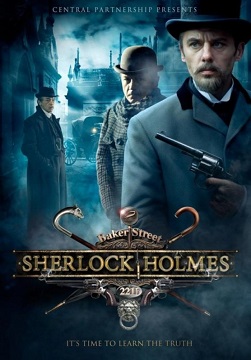
Sherlock Holmes is a Russian television crime drama series based on the Sherlock Holmes detective stories by Arthur Conan Doyle and aired in November 2013. It stars Igor Petrenko as Sherlock Holmes and Andrei Panin as Doctor John Watson. Eight episodes were produced.

The Irregulars is a British mystery adventure crime drama television series created by Tom Bidwell for Netflix. Loosely based on the works of Sir Arthur Conan Doyle, it features the Baker Street Irregulars working for Dr. Watson saving London from supernatural elements.















